Waste Tyre Solution
Present situation and pollution of waste tyre
With the rapid development of the automotive industry, the production of used tyres is also increasing. The term "waste tyres" refers to tyres that have been replaced or eliminated and have lost their usefulness as tyres, as well as scrap tyres produced by factories. Scrap tyres are very resistant to heat, mechanical, and hard to degrade. They will not naturally degrade and disappear within tens of years. They are known as "black pollution."
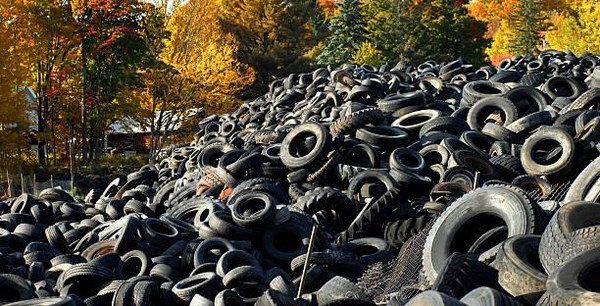 Piles of used tyres
Piles of used tyres
At present, the following problems exist in many waste tyre solutions in various countries:
1. The recycling rate is low, and the discarding of discarded tyres is very serious, which has a certain impact on the environment. At present, about 20% of used tyres are not used, piled up for a long time, hard to degrade, and become a source of black pollution.
2. The waste tyre recycling enterprises generally have a small scale of production and operation, low self-improvement ability, and no enterprise development. More than 80% of these companies are small and medium-sized enterprises or home-based workshops, which are not scaled and have low market competitiveness.
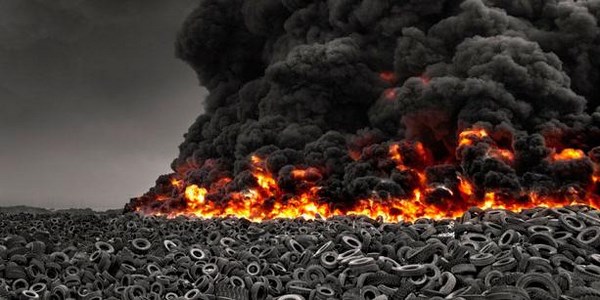 Burning waste tyres
Burning waste tyres
As a recyclable polymer material, used tyres have attracted attention from countries. In developed countries, used tyres are generally used free of charge, tax exemptions and government subsidies, and are supported by legislation that expands resource use.
At present, there are roughly three waste tyre solutions:
1. Direct used as port fenders and ship fenders, slope protection levees, road traffic wall screens, signposts, marine aquaculture reefs, amusement facilities, etc. But this kind of use of waste tyres is very limit.
2. Reycled to rubber powder or regenerated rubber, which in this process, high-temperature and high-pressure dynamic desulfurization generates secondary exhaust gas pollution, and there is a risk of burning and explosion in the production process. This waste tyre solution has led to a gradual decline in the production of recycled rubber, and some countries have stopped producing recycled rubber.
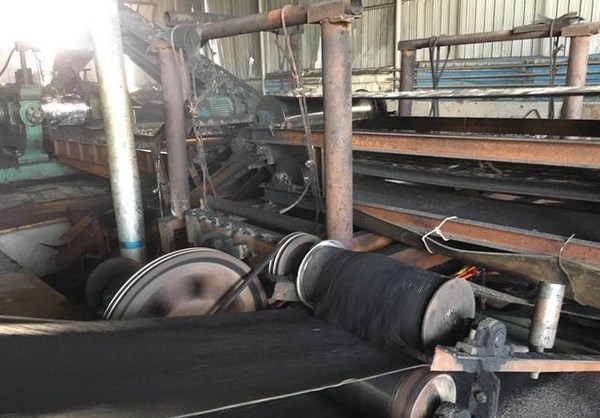 Waste tyres reycled to rubber powder
Waste tyres reycled to rubber powder
3. Retreading: This waste tyre solution has a higher requirement for the integrity of the tyre and has strict requirements on the retreading technology. In addition, the retreaded tyre still has a great potential safety hazard.
Waste tyre Solution & Thermal Cracking Technology
After the research and development of high value-added economic technology, the "thermal cracking" technology has been continuously improved, and the used tyre cracking technology has quietly advanced to the stage of industrial development with its unique advantages. This provides an optimal waste tyre solution, eradicating secondary pollution, alleviating energy crisis, and realizing resource recycling.
DOING rotary automatic waste tyre to oil pyrolysis plant introduced advanced cracking technology from Europe. It adopts high temperature and pressure cracking of used tyre production line. It splits used tyres into recyclable carbon black and fuel oil through cracking treatment and turns black waste into renewable resources. This system belongs to our innovative DOING system and mainly includes the following equipment: tyre crushing system, feeder, rotary pyrolysis reactor, slag discharger, condenser, deodorization system, and flue gas purification discharger.
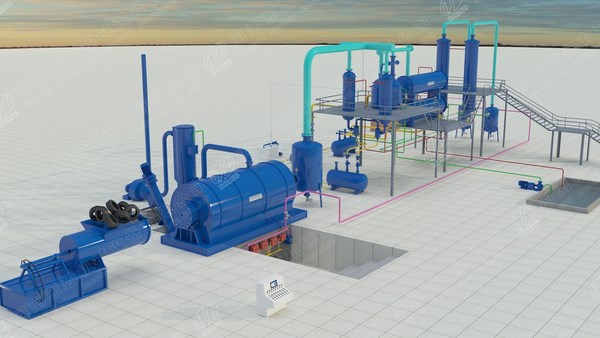 DOING waste tyre to oil pyrolysis plant
DOING waste tyre to oil pyrolysis plant
This technology allows waste tyres to enter the production cycle in the state of raw materials, which not only controls environmental pollution, but also brings about the recycling of resources. It has good social and economic benefits, and has become a new economic growth point for industrial recycling.
Compared with other waste tyre solutions, tyre thermal cracking has the following advantages:
1. Environmental protection
The condensing equipment adopts a tube-and-tube condenser design. The uncondensed oil and gas are taken in the tube. The water is taken away from the tube to exchange heat. The water and oil are in zero contact. The cooling water can be recycled (with a 50m3 cooling pool) to achieve zero discharge of waste water. The supporting innovation “Dust Removal + Dust Removal” double exhaust gas treatment system can make the non-condensable flammable gas produced in the process go through the deodorization system to remove the harmful gas with irritating odor and purify it before entering the reaction. The kettle combustion is used as a supplementary heat source. After the combustion, the dust-containing flue gas passes through the dust-removal tower to eliminate the harmful gas components and smoke and dust in the flue gas to reach the environmental protection standard.
2. Security
Our unique "leakage prevention technology", "Sandwich safety auger structure" and "carbon black anti-clogging exhaust" device, to ensure that the entyre operation of the equipment sealed, there is no blockage. Safeguard maintenance and prevent all accidents from happening.
3.Low labor costs
The entyre cracking equipment is a completely closed system with a relatively high degree of automation. The feed and slag do not need to be manually operated. They are all mechanically automated, thus saving labor.
4. High economic profits
The resulting carbon black and fuel oil have a wide range of uses and can be easily sold for high yields.
Investment-Profit Analysis
1. Economic Benefits
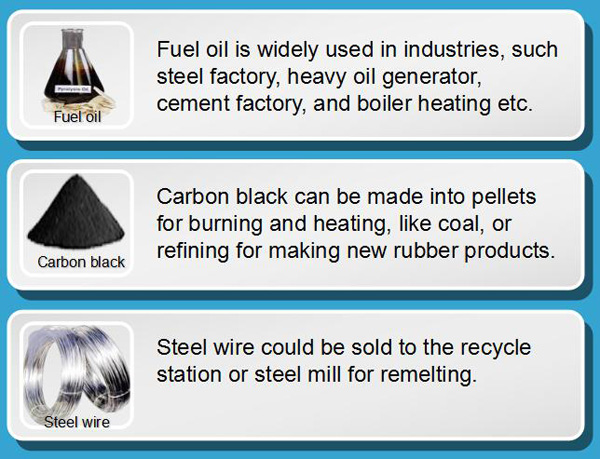 Final products of waste tyre to oil pyrolysis plant
Final products of waste tyre to oil pyrolysis plant
From the waste tyre solution we DOING developped, the final products are fuel oil, char, steel wire and uncondensable gas, which all could bring good benefits to the plant user.
(1) Fuel oil typically has medium viscosity and heating value more than 40MJ/kg, which could be widely used in industry as heating fuel. Also it could be further refined to clean diesel for more use by waste oil to diesel plant. The light fraction of fuel oil yields refined chemicals, such as BTEX and styrene, and the heavy fraction can enhance asphalt properties. The petrochemical industry can use the light olefins and aromatics in synthesis of chemicals (isoprene and 1, 3-butadiene), needed for tyre manufacturing. Pyrolytic oils have burned successfully in test furnaces and diesel engines (blended with diesel fuel).
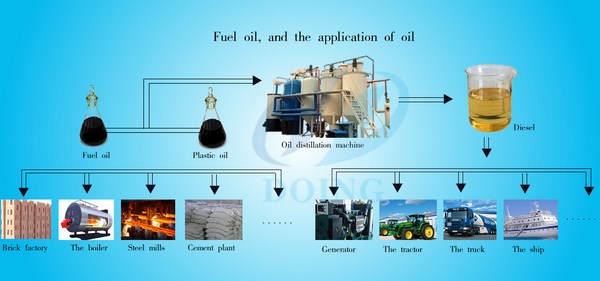 Fuel oil applications
Fuel oil applications
(2) The char fraction of tyre pyrolysis products ranges from 22 wt. % to 49 wt. %, with usual values of 38–40 wt. %. The char yield is high due to the carbon black contained in the original tyre. Char is generally composed of carbon, along with inorganics from tyre manufacture (e.g., Zn, Ca Si), with exact composition depending on pyrolysis conditions and tyre composition. Several studies have attempted to increase char commercial value by creating higher quality carbon black, or using steam or CO2 to create activated carbons with high surface areas (1000m2/g).
(3) Steel wire could be directly sold to recycling station or steel mill re-melted again for making new steel products.
(4) Uncondensable gas could be recycled to the pyrolysis furnace for heating directly. Major gas constituents include hydrogen (H2), methane (CH4), ethane (C2H6), ethene (C2H4), propane (C3H8), propene (C3H6), butane (C4H10), butene (C4H8), butadiene (C4H6), carbon dioxide (CO2), carbon monoxide (CO), and hydrogen sulfide (H2S). The exact gas composition depends on the specific rubbers used in tyre manufacture, as well as pyrolysis temperature.
2. Social Benefits
(1) The automatic waste tyre to diesel plant is based on the principle of cracking and regenerating carbon black. The recycling waste tyre solution that utilizes waste resources not only solves the problem of stack disposal of a large number of used tyres, but also obtains valuable resources and energy.
(2) In addition, the development of this waste tyre solution has, to a certain extent, eased the solid waste (tyre) disposal problems brought about by the development of the automobile industry, and is of great significance to the development of the national automobile industry and economic growth.
(3) After the waste tyre solution is implemented, it can partially solve the problem of local labor surplus, promote employment and stimulate the economic growth of the project site.



